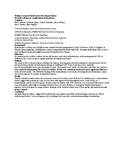| dc.contributor.author | English, Mike | |
| dc.contributor.author | Thoithi, Grace | |
| dc.contributor.author | Kitonyi, Grace | |
| dc.contributor.author | Karumbi, Jamlick | |
| dc.contributor.author | Opiyo, Newton | |
| dc.contributor.author | Mulaku, Mercy | |
| dc.date.accessioned | 2013-11-30T07:07:39Z | |
| dc.date.available | 2013-11-30T07:07:39Z | |
| dc.date.issued | 2013 | |
| dc.identifier.citation | Mulaku, Mercy .,Opiyo, Newton .,Karumbi,Jamlick ., Grace Kitonyi., Thoithi,Grace., English,Mike.,Evidence review of hydroxyurea for the prevention Of sickle cell disease complications in low-income Countries,2013 | en |
| dc.identifier.uri | http://hdl.handle.net/11295/61274 | |
| dc.description.abstract | Background:
Hydroxyurea is widely used in high-income countries for the management of sickle cell disease (SCD) in children. In Kenyan clinical guidelines, hydroxyurea is only recommended for adults with SCD. Yet many deaths from SCD occur in early childhood, deaths that might be prevented by hydroxyurea therapy.
Objectives:
To summarize the available evidence on the effectiveness and safety of hydroxyurea in the management of SCD in children below 5 years of age to support guideline development in Kenya.
Methods:
We searched The Cochrane Library, PubMed and Clinical Trial Registries for both randomised controlled trials (RCTs) and observational studies of hydroxyurea therapy in childhood SCD. Critical outcomes were: mortality,
rates of hospitalization and severe neurological events. Review processes (study selection, data extraction, data analysis) were conducted independently by at least two authors. Results were summarized narratively given significant differences in the included studies. The GRADE (Grading of Recommendations Assessment, Development and Evaluation) system was used to appraise the quality of identified evidence.
Results:
Overall, available evidence from one systematic review (n=26 studies), two RCTs (n=354 children) and 14 observational studies suggest that hydroxyurea may be associated with improved fetal hemoglobin levels, reduced rates of hospitalization and decreased frequency of pain events in children with SCD. However, it is associated with adverse events (e.g. neutropenia) when high to maximum tolerated doses are used. Evidence is lacking on whether hydroxyurea
improves survival if given to young children. Majority of the included studies were of low quality and mainly from high income countries.
Conclusion:
Available limited evidence suggests that hydroxyurea may improve morbidity and hematologic outcomes in SCD in children aged below 5 years and appears safe in settings able to provide consistent haematological monitoring. | en |
| dc.language.iso | en | en |
| dc.publisher | University of Nairobi | en |
| dc.title | Evidence review of hydroxyurea for the prevention Of sickle cell disease complications in low-income Countries | en |
| dc.type | Presentation | en |
| local.publisher | School of Medicine | en |

